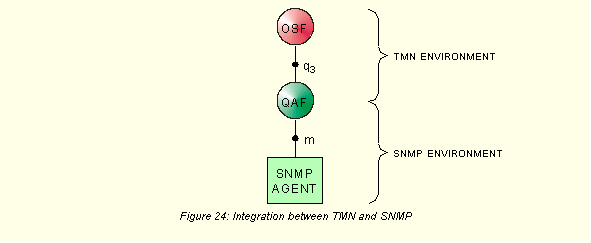An important difference between TMN and Internet management is that the first concentrates on the specification of management architectures and the second on the implementation of management protocols . As a result, there are only a limited number of TMN products on the market, whereas there are many commercial as well as public domain Internet management products. In fact, the Internet community did not bother about management architectures until they discovered that they could only obtain sufficient support for their new management protocol if they introduced a modular architecture for SNMPv3. As compared to the rich collection of architectural concepts defined by TMN, the SNMPv3 architecture remains relatively simple.
Integration between TMN and SNMP has been an important research topic and many research groups, in particular groups funded by the European RACE programme, addressed this topic. Integration is usually obtained via a Q Adaptor Function (QAF). The QAF translates between the q 3 reference point, which is implemented as an OSI management protocol stack (CMIP), and the m reference point, which is implemented as an Internet management (SNMP) protocol stack. The most critical task of the QAF is to translate between TMN's information model, which uses the OSI Guidelines for the Definition of Managed Objects (GDMO), and the Internet's Structure of Management Information (SMI).

As opposed to Internet management, the TMN specifications suggest a conceptual separation between the network that is managed (the telecommunication network) and the network that transfers the management information (the Data Communication Network, DCN). Members of the Internet management group took a different approach: they preferred to use the same components for the network that is managed and the network over which management information is transferred. The idea to introduce a separate network to transfer management information is comparable to the idea to introduce a separate network to exchange signalling information. In this sense TMN resembles the SS No. 7 network.
Probably TMN's most valuable concept is the Logical Layered Architecture (LLA). This architecture distinguishes between element, network, service and business management. Internet management has traditionally focused on element and network management, but needs to extend in the direction of service management to allow the exchange of management information between different operators as well as between customers and operator. The question of how to extend the Internet management framework with service management is investigated by research groups within the IRTF .